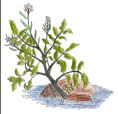|
Morphological Description
|
Plant Type: small glabourous perennial, creeping or floating, rooting habit. Hollow, angular, vascular, non woody stem, shoots arranged in a spiral. Racemose inflorescence (indefinite). Procumbent. Roots below ground, then ascending or floating foliage. Flowers white.
Leaves: pinnate or pinnafid arranged, in spiral, green all year. No stipules. Lowest leaves semi aquatic, stalked with 1 to 3 sessile, auricled. With 5 to 9 more leaflets. Terminal leaflet roundish or broadly cordate. Laterals entire or sinnuate toothed. Described as lyre shaped.
Flowers: small, white, in racemose inflorescence at terminal racemes. Pedicelled, bisexual, actinomorphic. Sepals in 2 decussate pairs. Petals 4, free, placed diagonally, alternating with sepals. Stamens hypogymous, 6. Outer transverse pair with short filaments. 2 inner pairs with long filaments. One at back one at front, close and beside ovary. Ovary superior and synocarpous. Fusion of the whole carpel. Degree of fusion indicates specialisation.
Many ovules on each of 2 parential placentae. Two celled and meet by outgrowths from placentae. Style single.
Fruit: slender midrib. Opens from below by 2 valves which leave seeds attached to a framework consisting of the adjoining wall tissue (replum) and septum (partition).
Sometimes indehescient either because seeds are restricted to the beak or valves do not open.
Seeds: two distinct rows in each cell with approx. 25 polygonal depressions in each face of seed case.
They are non endospermic and have accumbent cotyledons = standing against the radicle.
|


